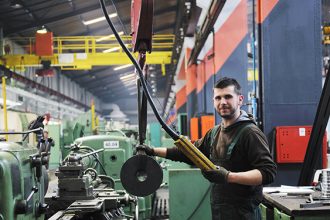
Nearly every warehouse and distribution center touts “safety first” as an operational mandate; yet some operations have better safety records than others. With the Bureau of Labor Statistics noting that annual warehouse fatalities doubled between 2015 and 2017, and warehouse injury rates hovering at 1.5 per 100 full-time associates, companies are increasingly turning to training tools that have proven to be most effective. These best practices were recently discussed in the MHI Solutions article, “Safety Training.”
Among the recommendations made by four safety training experts who contributed to the article were:
- Develop training following the “ADDIE” method: analyze, design, develop, implement and evaluate. This includes conducting a training needs assessment to determine if a problem is caused by a lack of training or simply by the difficulty of the task at hand or equipment used. The training itself should be designed to solve a specific issue. Further, a focus should be placed on reviewing metrics before and after the training to determine if the program was effective.
- Conduct observational, in-the-moment training to catch and correct behaviors that might contribute to the risk of injury.
- Engage employees with micro-learning sessions held on the floor for a maximum of five minutes — as opposed to traditional, classroom-based training that relies on hours of lecture. These mini sessions can be conducted at the start of each shift or sent to an employee’s phone or tablet for a quick read. To verify effectiveness, a follow-up questionnaire can be sent to participants to gauge how much they remember.
- Emphasize hands-on learning, which is the training format most likely to be remembered.
- Offer training in a variety of formats, as everyone learns differently. Visual learners prefer to watch a video or see someone perform a task. Others prefer audible instructions. Let workers choose the format that works best for them.
- Consider virtual reality (VR) training to give an employee the experience of navigating a dangerous scenario that would put him or her in danger if attempted in real life. Forklift manufacturers, for example, offer VR simulators that allow drivers to learn to operate and navigate through a variety of different lifting and load handling scenarios without endangering trainees, pedestrians, equipment, or structures within the facility.
- New wearables monitor an employee’s activity, documenting and warning the wearer if they bend or twist beyond a certain point or attempt to lift something too heavy. Analysis of the collected data can inform more targeted training to address a specific issue.
- Targeted, adaptive learning software allows an organization to pinpoint areas of safety competency and deficiency, then delivers only the information that needs to be repeated.
Additionally, the MHI Solutions article discusses different strategies to encourage compliance with training. These include gathering input about a process from the workers who do the job in question; tasking supervisors with performing routine work observations that include safe handling as part of the assessment; acknowledging employees who stick to the training when noted on-the-spot, which cultivates a feeling of appreciation.
Want more recommendations for improving the safety and productivity of your workforce? The Ergonomic Assist Systems & Equipment (EASE) Industry Group and the Protective Guarding Manufacturers Association (ProGMA) offer a variety of resources on their websites.



